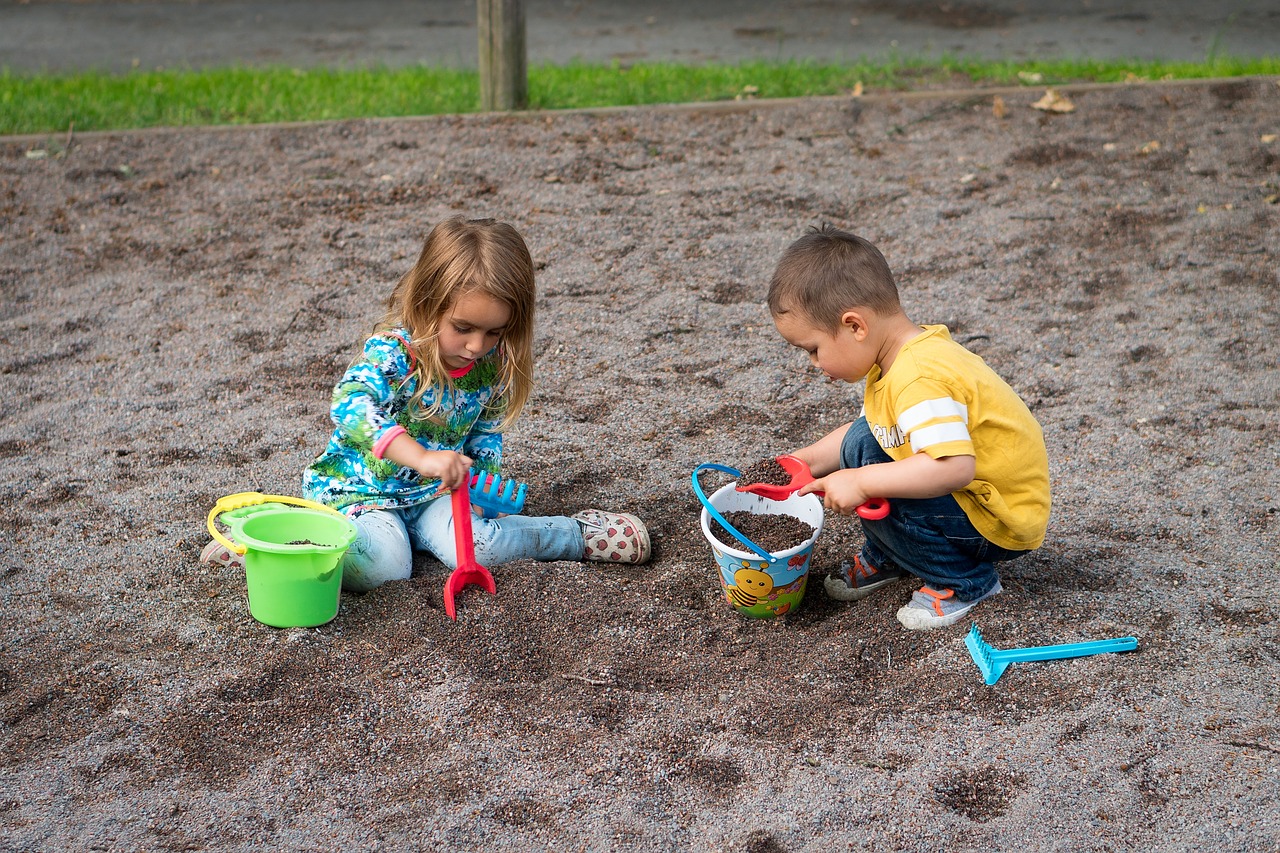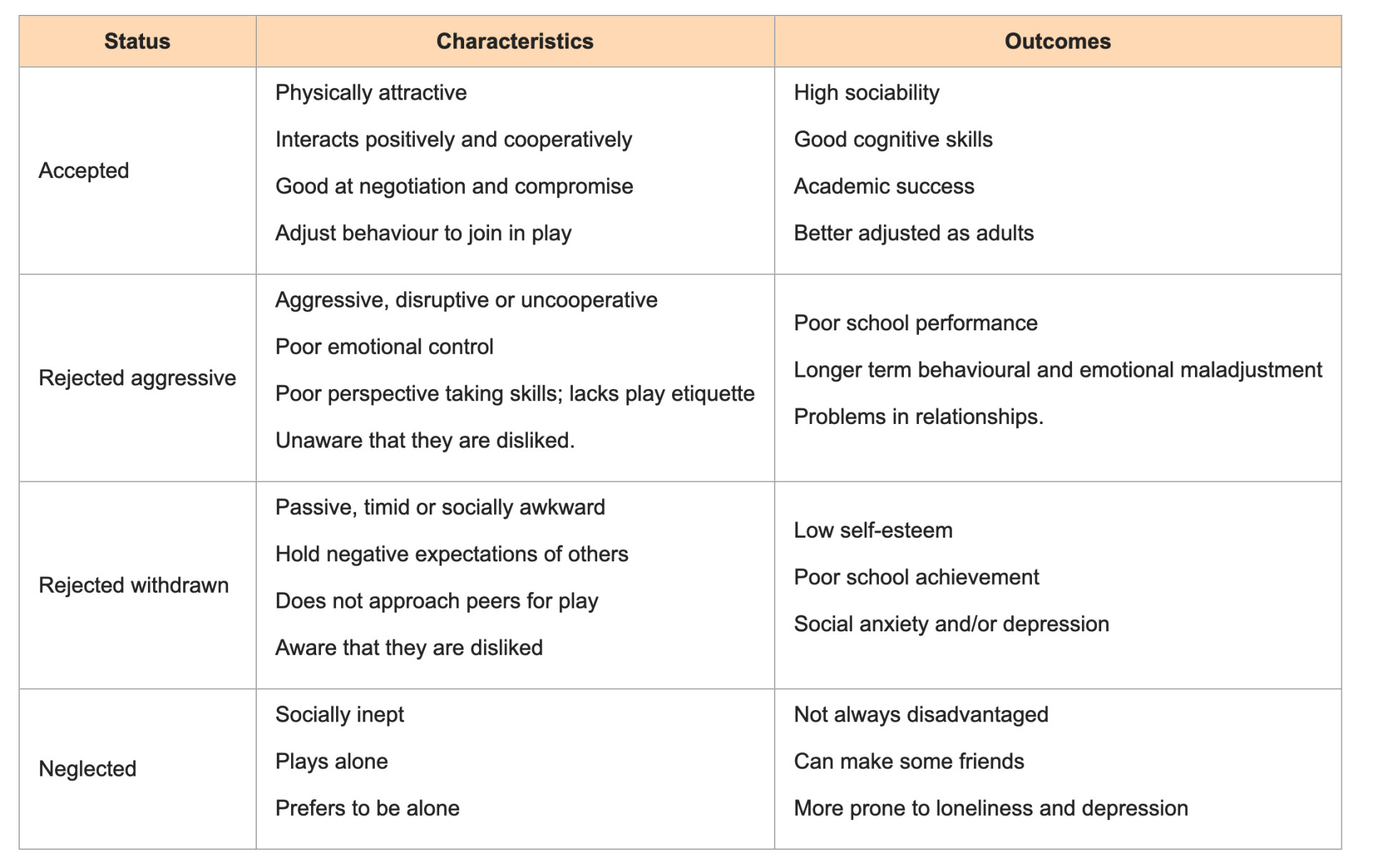Coie and Dodge (1988)
 Developmental researchers have found that peers and play are important factors in both the social and cognitive development of children. When children are accepted by their peers and engage in interactive play, this may lead to healthy development. When children are rejected, this may have a significant effect on their school performance, but also on their ability to form relationships. This also may have an impact on their mental health.
Developmental researchers have found that peers and play are important factors in both the social and cognitive development of children. When children are accepted by their peers and engage in interactive play, this may lead to healthy development. When children are rejected, this may have a significant effect on their school performance, but also on their ability to form relationships. This also may have an impact on their mental health.
Coie and Dodge's (1988) observational study had the goal of observing children in their school environment over a period of time to see how peer status played a role on their behaviour.
An important variable in a child's development is their sociometric status - that is, the extent to which children are accepted versus rejected by their peers. There are five categories of sociometric status: popular, rejected, neglected, controversial and average children.
Sociometric status is evaluated by asking children to nominate the peers whom they most like and dislike. Teachers, parents, and researchers also can provide their observations. The categories are defined as follows:
- Popular children receive many positive and few negative nominations. They are also referred to as "accepted" children.
- Rejected children receive many negative and few positive nominations. They are also referred to as rejected withdrawn.
- Neglected children receive few positive and few negative nominations.
- Controversial children receive both positive and negative nominations. They are well liked by some children but actively disliked by others. They are also referred to as "rejected aggressive."
- Average children receive an average number of positive and negative nominations. Most children fit into this category.
Rejected children, especially rejected-aggressive children, are at high risk for negative outcomes such as delinquency, hyperactivity, attention deficit hyper-activity disorder, conduct problems, and substance abuse. In addition, they are at higher risk than are the other groups for feelings of loneliness, depression, and for obsessive-compulsive disorder.
Psychologists study these classroom dynamics with the goal of identifying a child's status with the goal of providing interventions to help children better interactive with their peers. Interventions are often successful and can have positive lifelong implications.
Coie and Dodge (1988) carried out a naturalistic overt observations in 25 first-grade and 28 third-grade classrooms in Durham, North Carolina. Only boys were observed. The schools were urban; the children were predominantly of lower socioeconomic status.
In order to select the children to be observed, the researchers carried out sociometric testing, having each boy nominate three classmates whom they like most and three whom they liked least. Although the nominations could be from either gender, the researchers focused on data regarding male popularity. Children were also asked to nominate classmates who best fit one of the following descriptors: starts fights, is disruptive, angers easily, is cooperative, is a leader, is good at sports, is funny, or is unhappy.
Teachers were also given a 17-item behavioural checklist for the children who were then selected to be observed.
The researchers trained three African-American women to carry out the observations. Before the observations started, the research assistants spent time in the classroom to get the children used to having them in their learning environment.
Observations were conducted in the classrooms as well as during lunchtime, for a total of 60 minutes per child. Observations were conducted in five-minute blocks of time. After the observation was completed, the observer would randomly choose another boy from the list to observe for five-minutes. When all of the boys on the list had been observed, the observer would either start back at the top of the list, or she would discontinue observations for that day. Observations took place over three consecutive days for a total of 3600 observations. 720 of the observations (20%) were carried out by two researchers in order to determine the inter-rater reliability of the observations. The overall reliability of the observations was 0.95.
The observers made note of how the children responded to five categories of play: solitary behaviour; approaching another peer; a peer approaches them; interactive behaviour; teacher-initiated behaviour.
In comparing the behaviour of children in first and third grade, the researchers were able to not only identify behaviours according to their sociometric status, but also begin to note some of the outcomes of that status.

The study was cross-sectional. Although conclusions were drawn about the behaviours based on sociometric status in first grade, the conclusions about outcomes of a child's status is drawn in third-grade. This design allows researchers to save time, but it also makes an assumption about the third-grade child's sociometric status when he was in first-grade. However, there are ethical considerations here. If intervention can help a child avoid negative outcomes by third grade, a prospective longitudinal study may be seen as unethical.
The difference between the two groups was only two years in age. This is not enough to draw conclusions about the long-term effects of sociometric status. The researchers note this in the original study.
The data demonstrated a high rate of internal reliability. There was high agreement between teacher and student assessments of the children in the classroom. In addition, there was high inter-rater reliability between the observers.
The study was done in a naturalistic setting, meaning that the study has high ecological validity. Even though the observers spent some time in the classroom previous to the study to acclimate the children to their presence, there is still a question of whether knowing that they were being observed would affect the behaviour of the children. This could lead to demand characteristics - although this does not appear to be a trend, based on the fact that the data was as expected.
There was a very large sample size. However, it was all male and all from a lower socioeconomic class. There would be limitations to the generalizability of the findings.

 IB Docs (2) Team
IB Docs (2) Team
